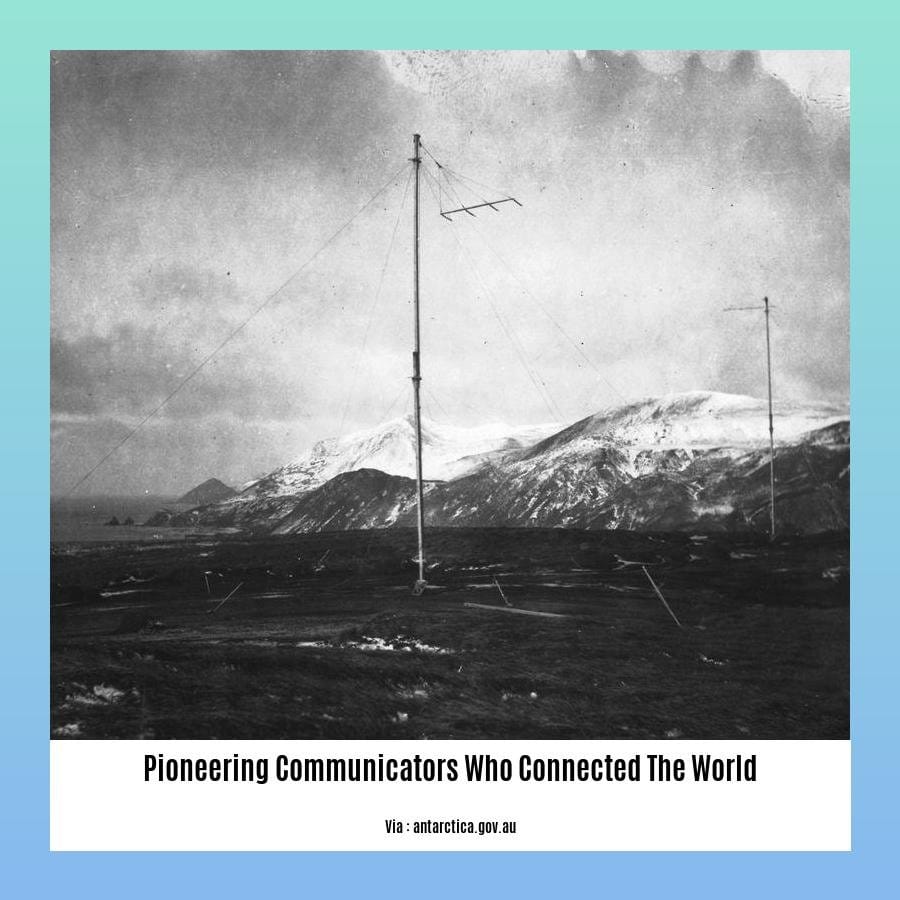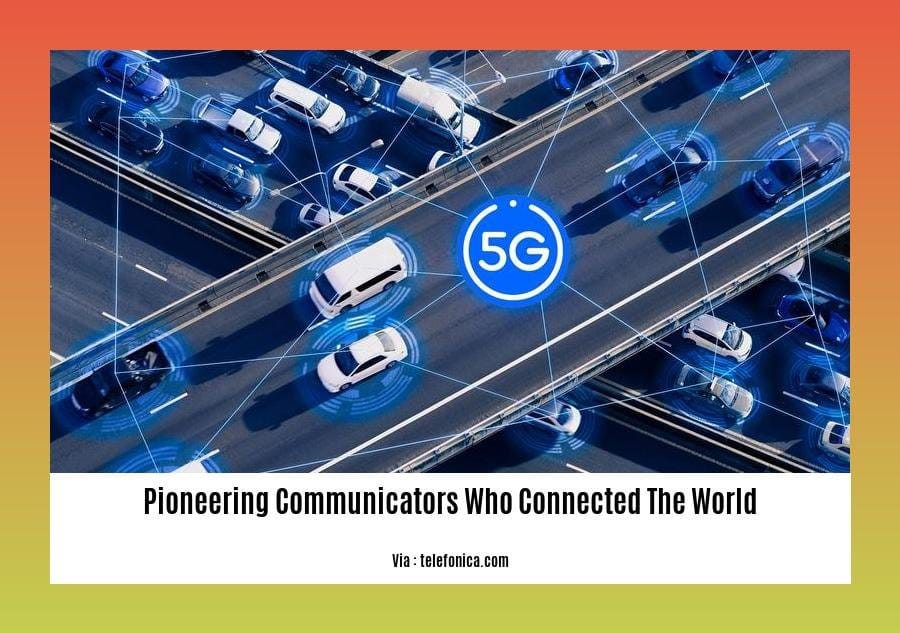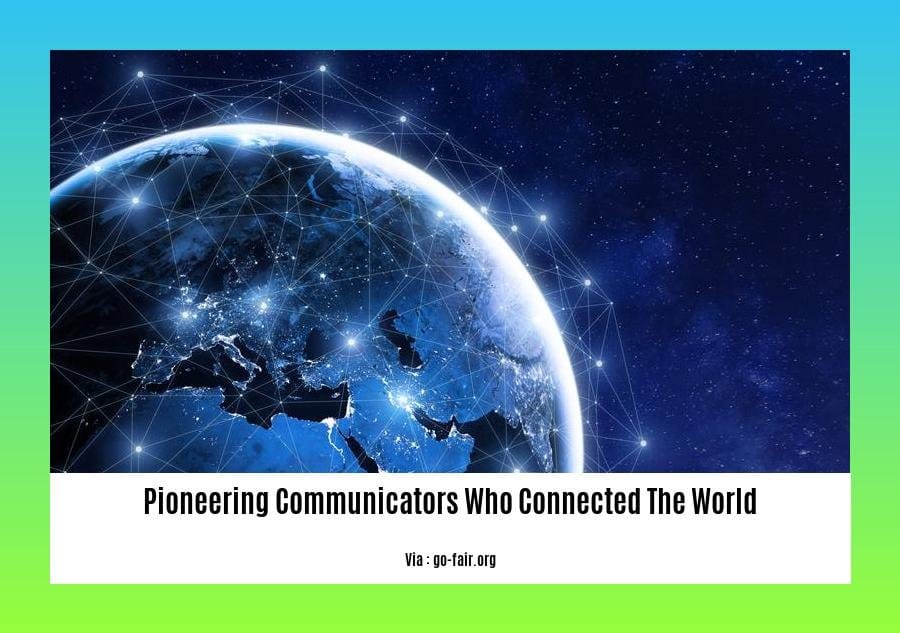Step into the annals of communication history with “Pioneering Communicators Who Connected the World: The Unsung Heroes of Global Connectivity.” This article unveils the remarkable stories of innovators who bridged vast distances, transforming human connection forever. From the ancient messengers to the inventors of the telephone and the internet, we explore the milestones that paved the way for our interconnected world.
Key Takeaways:

- The first postal system was created by Cyrus around 600-530 BC.
- Aristotle established the principles of rhetoric and communication theory in the 4th century BC.
- Johannes Gutenberg revolutionized information dissemination with the invention of the printing press in the 15th century.
- Claude Chappe developed the semaphore system in the 18th century, allowing for early long-distance communication.
- Sir Charles Wheatstone invented the telegraph in the 19th century, enabling near-instantaneous communication over great distances.
Pioneering Communicators Who Connected the World
Throughout history, visionary minds have dedicated their lives to bridging communication barriers and fostering global connections. Their unwavering determination and groundbreaking inventions laid the groundwork for the interconnected world we know today.
Aristotle: The Father of Rhetoric and Communication Theory
Ancient philosopher Aristotle delved into the art of persuasion and defined the fundamental principles of effective communication. His teachings on rhetoric, logic, and argumentation continue to shape the way we communicate to this day.
Johannes Gutenberg: The Revolutionary Printer
Johannes Gutenberg’s invention of the printing press in the 15th century marked a pivotal moment in human history. The mass production of books and written materials transformed the dissemination of knowledge and ideas, empowering individuals and societies.
Claude Chappe: The Pioneer of Optical Telegraph
In the late 18th century, Claude Chappe devised the semaphore system, a network of towers that used visual signals to transmit messages over long distances. This innovative technology laid the foundation for optical communication and paved the way for future advancements.
Sir Charles Wheatstone: The Inventor of the Telegraph
Sir Charles Wheatstone’s invention of the telegraph in the 19th century revolutionized long-distance communication. By transmitting electrical signals over wires, the telegraph enabled near-instantaneous exchange of information across vast geographical distances.
Meet the visionaries who united the globe, whose revolutionary ideas and inventions brought the world closer together. From the trailblazing innovators in global connectivity who laid the groundwork for modern communication to the pioneers who erased distances between people through transportation and technology, these extraordinary individuals shaped our interconnected world.
Old Ways Of Communication Before Technology
Before the marvels of modern communication graced our world, people relied on a tapestry of ingenious methods to bridge distances and share ideas.
Ancient Forms of Communication:
Carvings etched into stone, known as petroglyphs, served as early forms of storytelling. Pictures and symbols called pictograms and ideograms conveyed complex messages.
Development of Writing:
Around 3500 BCE, the Sumerians in Mesopotamia revolutionized communication with the creation of cuneiform, the first known writing system. Centuries later, the Phoenicians introduced an alphabet that spread throughout the Mediterranean.
Letter Writing and Postal Systems:
Papyrus in ancient Egypt and parchment in medieval Europe became the primary means of written communication. The emergence of postal services in the 17th century enabled messages to traverse great distances.
Telegraph:
In the early 19th century, Samuel Morse invented the telegraph, transforming long-distance communication. Using Morse code, messages could be transmitted over wires, heralding a new era of near-instantaneous communication.
Key Takeaways:
- Old Ways Of Communication Before Technology were essential for human connection and progress.
- Pictographs and ideograms allowed for the expression of complex ideas.
- Writing systems, like cuneiform and the Phoenician alphabet, revolutionized communication.
- Letter writing and postal systems enabled the exchange of ideas over long distances.
- The telegraph opened a new chapter in long-distance communication.
[Source: “History of Communication – Wikipedia”] (
Global Communication Examples
Imagine a world without the ability to instantly connect with people across oceans and continents. It’s hard to fathom in today’s interconnected world, but there was a time when global communication was a distant dream.
Overcoming geographical barriers and enabling real-time information exchange has been a remarkable journey. Let’s delve into some pioneering examples that paved the way for our modern-day connectivity:
Telegraphy: The Telegraph Revolution
The invention of the telegraph in the 19th century marked a pivotal moment in global communication. This technology allowed for near-instantaneous transmission of messages over long distances, revolutionizing the way news and information traveled. The telegraph played a crucial role in the global economy, facilitating trade, diplomacy, and communication during times of war and peace.
Transatlantic Cable: Connecting Continents
In 1866, the first successful transatlantic telegraph cable was laid, establishing a direct communication link between Europe and North America. This milestone enabled faster and more reliable communication between the continents, fostering closer ties and economic integration.
Radio and Satellite Communication: Breaking Barriers
The advent of radio and satellite communication in the 20th century further expanded the reach of global connectivity. Radio allowed for wireless transmission of voice and data, while satellites provided a means of communication over vast distances and remote areas. These technologies played a vital role in global news dissemination, disaster relief, and international diplomacy.
The Internet: A Global Network
The development of the internet in the late 20th century revolutionized global communication. This interconnected network of networks enabled digital communication, information sharing, and collaboration on an unprecedented scale. The internet has fostered the growth of global communities, facilitated international business, and empowered individuals with access to vast amounts of information.
Key Takeaways:
- Global communication has evolved from ancient forms to modern technologies, breaking down geographical barriers.
- Global Communication Examples, like the telegraph and the internet, have played a pivotal role in connecting the world.
- Communication technologies have facilitated knowledge sharing, economic integration, and global collaboration.
- With each advancement in communication technology, the world becomes a more connected and accessible place.
Most Relevant URL Source:
Connecting the World: The Role of Telecommunication in Global Communication

FAQ
Q1: What were the major advancements in communication before the telegraph?
A1: Ancient forms of communication included petroglyphs, pictograms, and ideograms. The development of writing in Mesopotamia, the Middle East, and Egypt facilitated the exchange of information. Letter writing and postal systems emerged in ancient Egypt and medieval Europe.
Q2: Who is credited with inventing the telegraph?
A2: Samuel Morse invented the telegraph in the early 19th century. It used Morse code to transmit messages over long distances, revolutionizing communication.
Q3: How did telegraphy impact global communication?
A3: Telegraphy made it possible to share both personal news and major world events across vast distances. It became a critical infrastructure for the global economy, enabling faster and more efficient communication.
Q4: What are some of the potential drawbacks of global communication?
A4: Global communication can lead to cultural imperialism and economic inequality due to the dominance of certain communication technologies. It’s important to address these issues to ensure equitable access and cultural diversity.
Q5: How has global communication evolved in recent years?
A5: The rise of social media, cloud computing, and other cutting-edge technologies has significantly enhanced cultural exchange and understanding among people worldwide. These advances continue to shape the evolution of global communication, creating new opportunities for collaboration and innovation.















